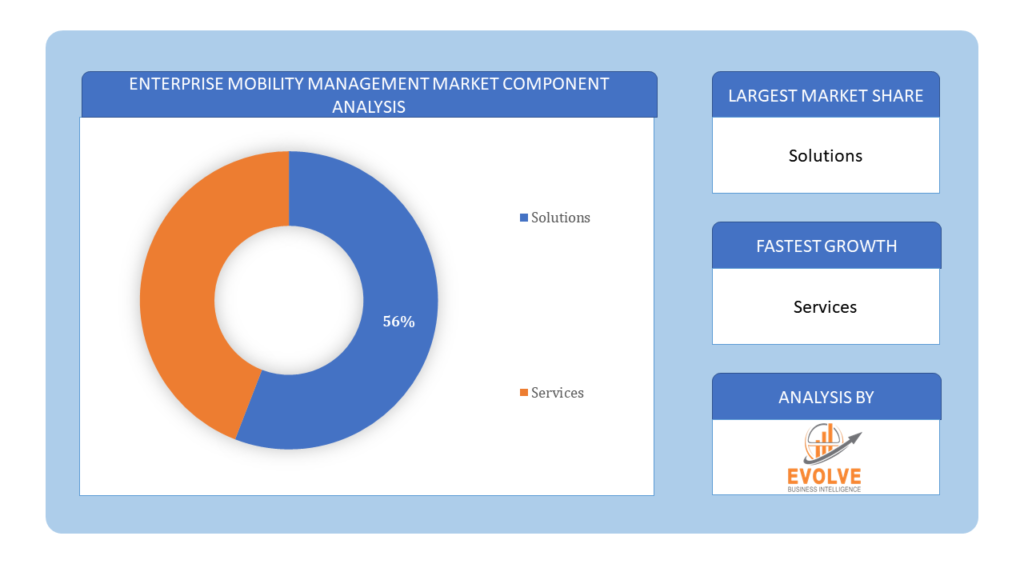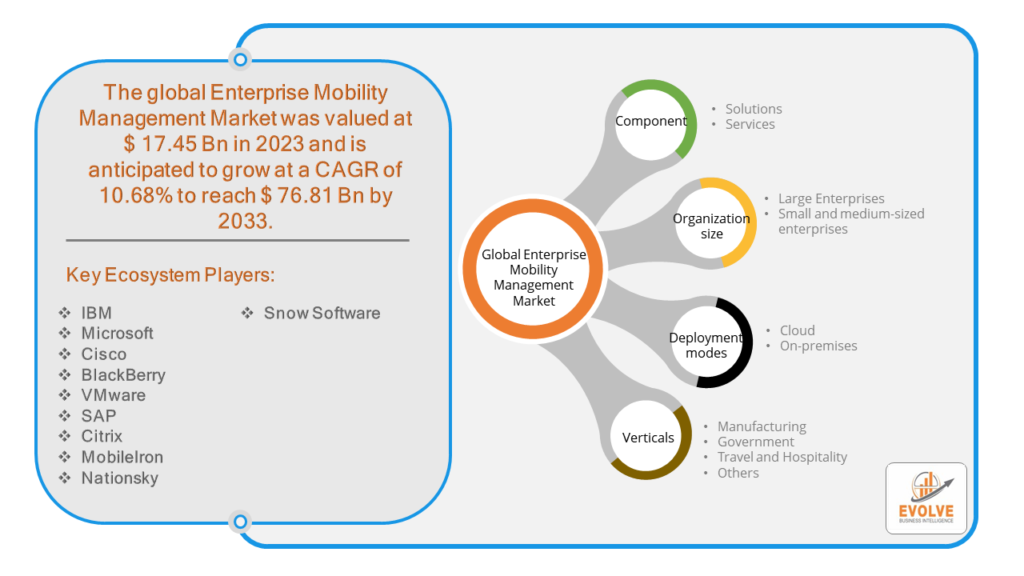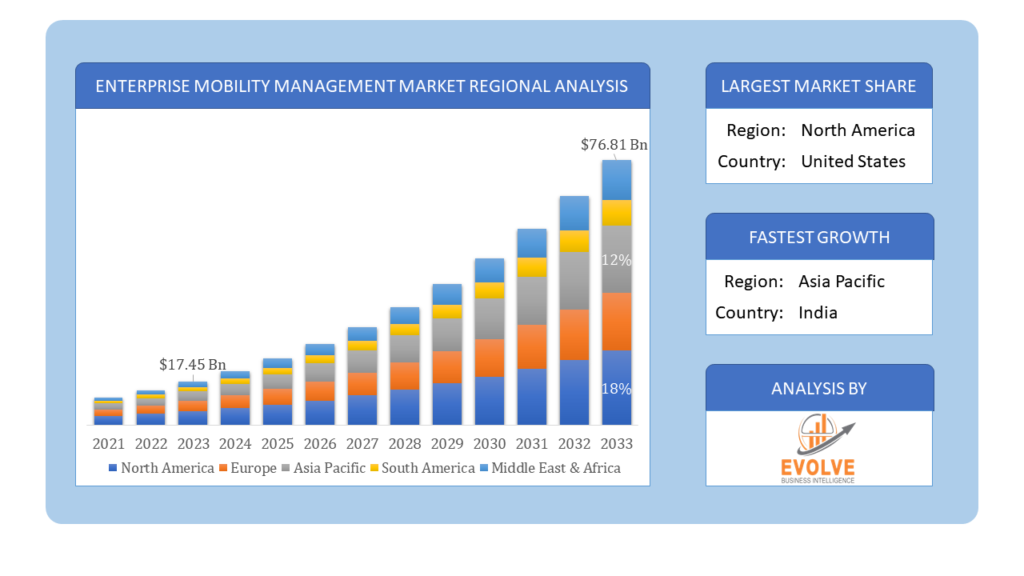Enterprise Mobility Management Market Analysis and Global Forecast 2023-2033
$ 1,390.00 – $ 5,520.00Price range: $ 1,390.00 through $ 5,520.00
Enterprise Mobility Management Market Research Report: By Component(Solutions, Services), By organization size(Large Enterprises, Small and Medium-Sized Enterprises), By deployment modes(Cloud, On-premises), By verticals(Manufacturing, Government, Travel, and Hospitality, Others), and by Region — Forecast till 2033
Page: 163
Enterprise Mobility Management Market Overview
Enterprise Mobility Management Market Size is expected to reach USD 76.81 Billion by 2033. The Enterprise Mobility Management industry size accounted for USD 17.45 Billion in 2023 and is expected to expand at a compound annual growth rate (CAGR) of 10.68% from 2023 to 2033. The Enterprise Mobility Management (EMM) market focuses on solutions designed to manage mobile devices, wireless networks, and related services in a business context. EMM encompasses tools for device management, application management, security, and content management, ensuring secure and efficient use of mobile technology in enterprises. It addresses the growing need for organizations to support mobile workforces while protecting corporate data and compliance requirements. The market is driven by the increasing adoption of mobile devices in business operations, the need for enhanced security, and the trend toward remote work and BYOD (Bring Your Own Device) policies.
Global Enterprise Mobility Management Market Synopsis
The COVID-19 pandemic has led to supply chain disruptions leading to supply shortages or lower demand in the Enterprise Mobility Management market. The travel restrictions and social-distancing measures have resulted in a sharp drop in consumer and business spending and this pattern is to continue for some time. The end-user trend and preferences have changed due to the pandemic and have resulted in manufacturers, developers, and service providers to adopt various strategies to stabilize the company.
Global Enterprise Mobility Management Market Dynamics
The major factors that have impacted the growth of Enterprise Mobility Management are as follows:
Drivers:
⮚ Advancements in Mobile Technology
Continuous advancements in mobile technology, including 5G, artificial intelligence, and the Internet of Things (IoT), are expanding the scope and capabilities of mobile devices in the enterprise environment. EMM solutions evolve in tandem with these technologies, offering advanced management and security features.
Restraint:
- Data Privacy Concerns
The deployment of EMM solutions involves accessing and managing a significant amount of personal and corporate data. Ensuring data privacy and protection while using these systems is a major concern for organizations. Employees may also have reservations about privacy, particularly when personal devices are used for work purposes under BYOD policies.
Opportunity:
⮚ Advancements in Mobile Technology
Continuous innovations in mobile technology, including the proliferation of 5G networks, the Internet of Things (IoT), and artificial intelligence (AI), are expanding the capabilities of mobile devices. EMM solutions that incorporate these advanced technologies can offer improved performance, better connectivity, and more sophisticated management features, creating opportunities for growth and differentiation in the market.
Enterprise Mobility Management Market Segment Overview
By Component
 Based on the Component, the market is segmented based on Solutions, Services. The solutions segment dominates the EMM market, as EMM solutions form the core software components that enable organizations to manage and secure their mobile devices, applications, and content. EMM solutions include modules such as Mobile Device Management (MDM), Mobile Application Management (MAM), and Mobile Content Management (MCM), which are essential for enforcing security policies, ensuring compliance, and optimizing mobile device functionality across the enterprise
Based on the Component, the market is segmented based on Solutions, Services. The solutions segment dominates the EMM market, as EMM solutions form the core software components that enable organizations to manage and secure their mobile devices, applications, and content. EMM solutions include modules such as Mobile Device Management (MDM), Mobile Application Management (MAM), and Mobile Content Management (MCM), which are essential for enforcing security policies, ensuring compliance, and optimizing mobile device functionality across the enterprise
By Organization size
Based on Organization size, the market has been divided into Large Enterprises, Small and Medium-Sized Enterprises. The large enterprises segment is expected to dominate the EMM market due to the increasing adoption of mobile devices and the need for secure data management in large organizations.
By Deployment modes
Based on the Deployment modes, the market has been divided into Cloud, On-premises. The cloud-based deployment mode is expected to dominate the market and display substantial growth during the forecast period. This can be attributed to the advantages of cloud-based EMM solutions, including reduced costs, flexibility, and virtual access via the internet, which make them advantageous for organizations with distributed workforces
By Verticals
Based on Verticals, the market has been divided into Manufacturing, Government, Travel, and Hospitality, Others. Among these, the BFSI and Healthcare and Life Sciences sectors are expected to dominate the market due to the increasing adoption of mobile devices and the need for secure data management in these industries
Global Enterprise Mobility Management Market Regional Analysis
Based on region, the market has been divided into North America, Europe, Asia-Pacific, the Middle East & Africa, and Latin America. The area of North America is anticipated to dominate the market for the usage of Enterprise Mobility Management, followed by those in Asia-Pacific and Europe.
 Enterprise Mobility Management North America Market
Enterprise Mobility Management North America Market
The North American region holds a dominant position in the Enterprise Mobility Management market. Several important aspects are responsible for the expected growth of the Enterprise Mobility Management market in North America. The primary factor driving the demand for mobility solutions in the nation is the widespread acceptance of these solutions across a number of industries, including banking, retail, manufacturing, and healthcare. The healthcare sector has great promise for analytics, primarily due to the growing ubiquity of big data analytics throughout the nation’s healthcare infrastructure. This is anticipated to contribute to the growth of Enterprise Mobility Management (EMM) in the region throughout the forecast period.
Enterprise Mobility Management Asia Pacific Market
The Asia-Pacific region is witnessing rapid growth and emerging as a significant market for the Enterprise Mobility Management industry. From 2023 to 2032, the Asia-Pacific Enterprise Mobility Management Market is anticipated to expand at the quickest rate of compound annual growth (CAGR). Strong market prospects are being created for the EMM industry by government measures that support digital security and protect sensitive data. The number of cyberattacks on government networks has decreased as a result of improvements made to the Indian Computer Emergency Response Team (CERT-In), the nation’s central body for handling cyberthreats.
Competitive Landscape
The competitive landscape includes key players (tier 1, tier 2, and local) having a presence across the globe. Companies such as IBM, Microsoft, Cisco, BlackBerry, and VMware are some of the leading players in the global Enterprise Mobility Management Industry. These players have adopted partnership, acquisition, expansion, and new product development, among others as their key strategies.
Key Market Players:
- IBM
- Microsoft
- Cisco
- BlackBerry
- VMware
- SAP
- Citrix
- MobileIron
- Nationsky
- Snow Software
Key Development:
May 2020: In May 2020, BlackBerry introduced the BlackBerry Spark Suites, consisting of the BlackBerry Spark UEM Express Suite, BlackBerry Spark UEM Suite, BlackBerry Spark UES Suite, and BlackBerry Spark Suite.
December 2020, Cisco announced its intention to acquire Immobile, with both companies agreeing on the terms of a recommended cash offer. Cisco is set to pay 595 pence per share, resulting in an aggregate purchase price of approximately USD 730 million.
Scope of the Report
Global Enterprise Mobility Management Market, by Component
- Solutions
- Services
Global Enterprise Mobility Management Market, by Organization size
- Large Enterprises
- Small and medium-sized enterprises
Global Enterprise Mobility Management Market, by Deployment modes
- Cloud
- On-premises
Global Enterprise Mobility Management Market, by Verticals
- Manufacturing
- Government
- Travel and Hospitality
- Others
Global Enterprise Mobility Management Market, by Region
- North America
- US
- Canada
- Mexico
- Europe
- UK
- Germany
- France
- Italy
- Spain
- Benelux
- Nordic
- Rest of Europe
- Asia Pacific
- China
- Japan
- South Korea
- Indonesia
- Austalia
- Malaysia
- India
- Rest of Asia Pacific
- South America
- Brazil
- Argentina
- Rest of South America
- Middle East & Africa
- Saudi Arabia
- UAE
- Egypt
- South Africa
- Rest of Middle East & Africa
| Parameters | Indicators |
|---|---|
| Market Size | 2033: $76.81 Billion |
| CAGR | 10.68% CAGR (2023-2033) |
| Base year | 2022 |
| Forecast Period | 2023-2033 |
| Historical Data | 2021 |
| Report Coverage | Revenue Forecast, Competitive Landscape, Growth Factors, and Trends |
| Key Segmentations | Component, Organization size, Deployment modes, Verticals |
| Geographies Covered | North America, Europe, Asia-Pacific, Latin America, Middle East, Africa |
| Key Vendors | IBM, Microsoft, Cisco, BlackBerry, VMware, SAP, Citrix, MobileIron, Nationsky, Snow Software |
| Key Market Opportunities | Increasing BYOD presents larger growth opportunities for key players |
| Key Market Drivers | The increasing trend of working from home due to the COVID-19 pandemic drives the adoption of enterprise mobility management solutions |
REPORT CONTENT BRIEF:
- High-level analysis of the current and future Enterprise Mobility Management Industry trends and opportunities
- Detailed analysis of current market drivers, restraining factors, and opportunities analysis in the future
- Historical market size for the year 2021, and forecast from 2023 to 2033
- Enterprise Mobility Management market share analysis for each segment
- Competitor analysis with a comprehensive insight into its product segment, financial strength, and strategies adopted.
- Identifies key strategies adopted by the key players including new product development, mergers and acquisitions, joint ventures, collaborations, and partnerships.
- To identify and understand the various factors involved in the global Enterprise Mobility Management market affected by the pandemic
- To provide year-on-year growth from 2022 to 2033
- To provide short-term, long-term, and overall CAGR comparison from 2022 to 2033.
- Provide Total Addressable Market (TAM) for the Global Enterprise Mobility Management Market.
Press Release

Global Pharmaceutical Manufacturing Market to Reach $1.38 Trillion by 2035 with 7.35% CAGR, New Research Shows

The Global Mammography Market Is Estimated To Record a CAGR of Around 10.29% During The Forecast Period

Glue Stick Market to Reach USD 2.35 Billion by 2034

Podiatry Service Market to Reach USD 11.88 Billion by 2034

Microfluidics Technology Market to Reach USD 32.58 Billion by 2034

Ferric Chloride Market to Reach USD 10.65 Billion by 2034

Family Practice EMR Software Market to Reach USD 21.52 Billion by 2034

Electric Hairbrush Market to Reach USD 15.95 Billion by 2034

Daily Bamboo Products Market to Reach USD 143.52 Billion by 2034

Cross-border E-commerce Logistics Market to Reach USD 112.65 Billion by 2034
Frequently Asked Questions (FAQ)
What is the expected size of the Enterprise Mobility Management Market by 2033?
The market is expected to reach USD 76.81 billion by 2033
What is the CAGR of the Enterprise Mobility Management Market from 2023 to 2033?
The market is projected to grow at a compound annual growth rate (CAGR) of 10.68%
What are the key drivers of the Enterprise Mobility Management Market?
Key drivers include advancements in mobile technology, the trend toward remote work, and the increasing adoption of BYOD policies
Which region holds the dominant position in the Enterprise Mobility Management Market?
North America holds the dominant position, followed by Asia-Pacific and Europe
What are the major components of Enterprise Mobility Management solutions?
The major components include solutions such as Mobile Device Management (MDM), Mobile Application Management (MAM), and Mobile Content Management (MCM)
Table of Content
CHAPTER 1. Executive Summary CHAPTER 2. Scope of the Study 2.1. Market Definition 2.2. Market Scope & Segmentation 2.2.1. Objective of Report CHAPTER 3. Evolve BI Methodology 3.1. Data Collection & Validation Approach 3.2. Market Size Estimation and Forecast CHAPTER 4. Exclusive Analysis 4.1. Market Opportunity Score 4.1.1. Component Segement – Market Opportunity Score 4.1.2. Organization size Segment – Market Opportunity Score 4.1.3. Deployment modes Segment – Market Opportunity Score 4.1.4. Verticals Segment – Market Opportunity Score 4.2. Key Market Influencing Indicators CHAPTER 5. Market Insights and Trends 5.1. Value Chain Analysis 5.1.1. Component 5.1.2. Manufacturing Process 5.1.3. Distribution Channel 5.1.4. End User 5.2. Porter’s Five Forces Analysis 5.2.1. Bargaining Power of Buyers 5.2.2. Bargaining Power of Suppliers 5.2.3. Threat of New Entrant 5.2.4. Threat of Substitute 5.2.5. Industry Rivalry 5.3. COVID-19 Impact and Post COVID Scenario on Enterprise Mobility Management Market 5.3.1. Impact of COVID-19 5.3.2. Government Support and Industry Revival Policies 5.3.3. Measures Taken by Companies to Mitigate Negative Impact 5.3.4. Post COVID Trend CHAPTER 6. MArket Dynamics 6.1. Introduction 6.2. Drivers 6.2.1. Driver 1 6.2.2. Driver 2 6.2.3. Driver 3 6.3. Restraints 6.3.1. Restraint 1 6.3.2. Restraint 2 6.4. Opportunity 6.4.1. Opportunity 1 CHAPTER 7. Global Enterprise Mobility Management Market, By Component 7.1. Introduction 7.1.1. Solutions 7.1.2. Services CHAPTER 8. Global Enterprise Mobility Management Market, By Organization size 8.1. Introduction 8.1.1. Large Enterprises 8.1.2. Small and medium-sized enterprises CHAPTER 9. Global Enterprise Mobility Management Market, By Deployment modes 9.1. Introduction 9.1.1. Cloud 9.1.2. On-premises CHAPTER 10. Global Enterprise Mobility Management Market, By Verticals 10.1. Introduction 10.1.1 Manufacturing 10.1.2. Government 10.1.3. Travel and Hospitality 10.1.4. Others CHAPTER 11. Global Enterprise Mobility Management Market, By Region 11.1. Introduction 11.2. NORTH AMERICA 11.2.1. North America: Market Size and Forecast, By Country, 2023 – 2033 ($ Million) 11.2.2. North America: Market Size and Forecast, By Component, 2023 – 2033 ($ Million) 11.2.3. North America: Market Size and Forecast, By Organization size, 2023 – 2033 ($ Million) 11.2.4. North America: Market Size and Forecast, By Deployment modes, 2023 – 2033 ($ Million) 11.2.5. North America: Market Size and Forecast, By Verticals, 2023 – 2033 ($ Million) 11.2.6. US 11.2.6.1. US: Market Size and Forecast, By Component, 2023 – 2033 ($ Million) 11.2.6.2. US: Market Size and Forecast, By Organization size, 2023 – 2033 ($ Million) 11.2.6.3. US: Market Size and Forecast, By Deployment modes, 2023 – 2033 ($ Million) 11.2.6.4. US: Market Size and Forecast, By Verticals, 2023 – 2033 ($ Million) 11.2.7. CANADA 11.2.7.1. Canada: Market Size and Forecast, By Component, 2023 – 2033 ($ Million) 11.2.7.2. Canada: Market Size and Forecast, By Organization size, 2023 – 2033 ($ Million) 11.2.7.3. Canada: Market Size and Forecast, By Deployment modes, 2023 – 2033 ($ Million) 11.2.7.4. Canada: Market Size and Forecast, By Verticals, 2023 – 2033 ($ Million) 11.2.8. MEXICO 11.2.8.1. Mexico: Market Size and Forecast, By Component, 2023 – 2033 ($ Million) 11.2.8.2. Mexico: Market Size and Forecast, By Organization size, 2023 – 2033 ($ Million) 11.2.8.3. Mexico: Market Size and Forecast, By Deployment modes, 2023 – 2033 ($ Million) 11.2.8.4. Mexico: Market Size and Forecast, By Verticals, 2023 – 2033 ($ Million) 11.3. Europe 11.3.1. Europe: Market Size and Forecast, By Country, 2023 – 2033 ($ Million) 11.3.2. Europe: Market Size and Forecast, By Component, 2023 – 2033 ($ Million) 11.3.3. Europe: Market Size and Forecast, By Organization size, 2023 – 2033 ($ Million) 11.3.4. Europe: Market Size and Forecast, By Deployment modes, 2023 – 2033 ($ Million) 11.3.5. Europe: Market Size and Forecast, By Verticals, 2023 – 2033 ($ Million) 11.3.6. U.K. 11.3.6.1. U.K.: Market Size and Forecast, By Component, 2023 – 2033 ($ Million) 11.3.6.2. U.K.: Market Size and Forecast, By Organization size, 2023 – 2033 ($ Million) 11.3.6.3. U.K.: Market Size and Forecast, By Deployment modes, 2023 – 2033 ($ Million) 11.3.6.4. U.K.: Market Size and Forecast, By Verticals, 2023 – 2033 ($ Million) 11.3.7. GERMANY 11.3.7.1. Germany: Market Size and Forecast, By Component, 2023 – 2033 ($ Million) 11.3.7.2. Germany: Market Size and Forecast, By Organization size, 2023 – 2033 ($ Million) 11.3.7.3. Germany: Market Size and Forecast, By Deployment modes, 2023 – 2033 ($ Million) 11.3.7.4. Germany: Market Size and Forecast, By Verticals, 2023 – 2033 ($ Million) 11.3.8. FRANCE 11.3.8.1. France: Market Size and Forecast, By Component, 2023 – 2033 ($ Million) 11.3.8.2. France: Market Size and Forecast, By Organization size, 2023 – 2033 ($ Million) 11.3.8.3. France: Market Size and Forecast, By Deployment modes, 2023 – 2033 ($ Million) 11.3.8.4. France: Market Size and Forecast, By Verticals, 2023 – 2033 ($ Million) 11.3.9. ITALY 11.3.9.1. Italy: Market Size and Forecast, By Component, 2023 – 2033 ($ Million) 11.3.9.2. Italy: Market Size and Forecast, By Organization size, 2023 – 2033 ($ Million) 11.3.9.3. Italy: Market Size and Forecast, By Deployment modes, 2023 – 2033 ($ Million) 11.3.9.4. Italy: Market Size and Forecast, By Verticals, 2023 – 2033 ($ Million) 11.3.10. SPAIN 11.3.10.1. Spain: Market Size and Forecast, By Component, 2023 – 2033 ($ Million) 11.3.10.2. Spain: Market Size and Forecast, By Organization size, 2023 – 2033 ($ Million) 11.3.10.3. Spain: Market Size and Forecast, By Deployment modes, 2023 – 2033 ($ Million) 11.3.10.4. Spain: Market Size and Forecast, By Verticals, 2023 – 2033 ($ Million) 11.3.11. BENELUX 11.3.11.1. BeNeLux: Market Size and Forecast, By Component, 2023 – 2033 ($ Million) 11.3.11.2. BeNeLux: Market Size and Forecast, By Organization size, 2023 – 2033 ($ Million) 11.3.11.3. BeNeLux: Market Size and Forecast, By Deployment modes, 2023 – 2033 ($ Million) 11.3.11.4. BeNeLux: Market Size and Forecast, By Verticals, 2023 – 2033 ($ Million) 11.3.12. RUSSIA 11.3.12.1. Russia: Market Size and Forecast, By Component, 2023 – 2033 ($ Million) 11.3.12.2. Russia: Market Size and Forecast, By Organization size, 2023 – 2033 ($ Million) 11.3.12.3. Russia: Market Size and Forecast, By Deployment modes, 2023 – 2033 ($ Million) 11.3.12.4. Russia: Market Size and Forecast, By Verticals, 2023 – 2033 ($ Million) 11.3.13. REST OF EUROPE 11.3.13.1. Rest of Europe: Market Size and Forecast, By Component, 2023 – 2033 ($ Million) 11.3.13.2. Rest of Europe: Market Size and Forecast, By Organization size, 2023 – 2033 ($ Million) 11.3.13.3. Rest of Europe: Market Size and Forecast, By Deployment modes, 2023 – 2033 ($ Million) 11.3.13.4. Rest of Europe: Market Size and Forecast, By Verticals, 2023 – 2033 ($ Million) 11.4. Asia Pacific 11.4.1. Asia Pacific: Market Size and Forecast, By Country, 2023 – 2033 ($ Million) 11.4.2. Asia Pacific: Market Size and Forecast, By Component, 2023 – 2033 ($ Million) 11.4.3. Asia Pacific: Market Size and Forecast, By Organization size, 2023 – 2033 ($ Million) 11.4.4. Asia Pacific: Market Size and Forecast, By Deployment modes, 2023 – 2033 ($ Million) 11.4.5. Asia Pacific: Market Size and Forecast, By Verticals, 2023 – 2033 ($ Million) 11.4.6. CHINA 11.4.6.1. China: Market Size and Forecast, By Component, 2023 – 2033 ($ Million) 11.4.6.2. China: Market Size and Forecast, By Organization size, 2023 – 2033 ($ Million) 11.4.6.3. China: Market Size and Forecast, By Deployment modes, 2023 – 2033 ($ Million) 11.4.6.4. China: Market Size and Forecast, By Verticals, 2023 – 2033 ($ Million) 11.4.7. JAPAN 11.4.7.1. Japan: Market Size and Forecast, By Component, 2023 – 2033 ($ Million) 11.4.7.2. Japan: Market Size and Forecast, By Organization size, 2023 – 2033 ($ Million) 11.4.7.3. Japan: Market Size and Forecast, By Deployment modes, 2023 – 2033 ($ Million) 11.4.7.4. Japan: Market Size and Forecast, By Verticals, 2023 – 2033 ($ Million) 11.4.8. INDIA 11.4.8.1. India: Market Size and Forecast, By Component, 2023 – 2033 ($ Million) 11.4.8.2. India: Market Size and Forecast, By Organization size, 2023 – 2033 ($ Million) 11.4.8.3. India: Market Size and Forecast, By Deployment modes, 2023 – 2033 ($ Million) 11.4.8.4. India: Market Size and Forecast, By Verticals, 2023 – 2033 ($ Million) 11.4.9. SOUTH KOREA 11.4.9.1. South Korea: Market Size and Forecast, By Component, 2023 – 2033 ($ Million) 11.4.9.2. South Korea: Market Size and Forecast, By Organization size, 2023 – 2033 ($ Million) 11.4.9.3. South Korea: Market Size and Forecast, By Deployment modes, 2023 – 2033 ($ Million) 11.4.9.4. South Korea: Market Size and Forecast, By Verticals, 2023 – 2033 ($ Million) 11.4.10. THAILAND 11.4.10.1. Thailand: Market Size and Forecast, By Component, 2023 – 2033 ($ Million) 11.4.10.2. Thailand: Market Size and Forecast, By Organization size, 2023 – 2033 ($ Million) 11.4.10.3. Thailand: Market Size and Forecast, By Deployment modes, 2023 – 2033 ($ Million) 11.4.10.4. Thailand: Market Size and Forecast, By Verticals, 2023 – 2033 ($ Million) 11.4.11. INDONESIA 11.4.11.1. Indonesia: Market Size and Forecast, By Component, 2023 – 2033 ($ Million) 11.4.11.2. Indonesia: Market Size and Forecast, By Organization size, 2023 – 2033 ($ Million) 11.4.11.3. Indonesia: Market Size and Forecast, By Deployment modes, 2023 – 2033 ($ Million) 11.4.11.4. Indonesia: Market Size and Forecast, By Verticals, 2023 – 2033 ($ Million) 11.4.12. MALAYSIA 11.4.12.1. Malaysia: Market Size and Forecast, By Component, 2023 – 2033 ($ Million) 11.4.12.2. Malaysia: Market Size and Forecast, By Organization size, 2023 – 2033 ($ Million) 11.4.12.3. Malaysia: Market Size and Forecast, By Deployment modes, 2023 – 2033 ($ Million) 11.4.12.4. Malaysia: Market Size and Forecast, By Verticals, 2023 – 2033 ($ Million) 11.4.13. AUSTRALIA 11.4.13.1. Australia: Market Size and Forecast, By Component, 2023 – 2033 ($ Million) 11.4.13.2. Australia: Market Size and Forecast, By Organization size, 2023 – 2033 ($ Million) 11.4.13.3. Australia: Market Size and Forecast, By Deployment modes, 2023 – 2033 ($ Million) 11.4.13.4. Australia: Market Size and Forecast, By Verticals, 2023 – 2033 ($ Million) 11.4.14. REST FO ASIA PACIFIC 11.4.14.1. Rest fo Asia Pacific: Market Size and Forecast, By Component, 2023 – 2033 ($ Million) 11.4.14.2. Rest fo Asia Pacific: Market Size and Forecast, By Organization size, 2023 – 2033 ($ Million) 11.4.14.3. Rest fo Asia Pacific: Market Size and Forecast, By Deployment modes, 2023 – 2033 ($ Million) 11.4.14.4. Rest fo Asia Pacific: Market Size and Forecast, By Verticals, 2023 – 2033 ($ Million) 11.5. South America 11.5.1. South America: Market Size and Forecast, By Country, 2023 – 2033 ($ Million) 11.5.2. South America: Market Size and Forecast, By Component, 2023 – 2033 ($ Million) 11.5.3. South America: Market Size and Forecast, By Organization size, 2023 – 2033 ($ Million) 11.5.4. South America: Market Size and Forecast, By Deployment modes, 2023 – 2033 ($ Million) 11.5.5. South America: Market Size and Forecast, By Verticals, 2023 – 2033 ($ Million) 11.5.6. BRAZIL 11.5.6.1. Brazil: Market Size and Forecast, By Component, 2023 – 2033 ($ Million) 11.5.6.2. Brazil: Market Size and Forecast, By Organization size, 2023 – 2033 ($ Million) 11.5.6.3. Brazil: Market Size and Forecast, By Deployment modes, 2023 – 2033 ($ Million) 11.5.6.4. Brazil: Market Size and Forecast, By Verticals, 2023 – 2033 ($ Million) 11.5.7. ARGENTINA 11.5.7.1. Argentina: Market Size and Forecast, By Component, 2023 – 2033 ($ Million) 11.5.7.2. Argentina: Market Size and Forecast, By Organization size, 2023 – 2033 ($ Million) 11.5.7.3. Argentina: Market Size and Forecast, By Deployment modes, 2023 – 2033 ($ Million) 11.5.7.4. Argentina: Market Size and Forecast, By Verticals, 2023 – 2033 ($ Million) 11.5.8. REST OF SOUTH AMERICA 11.5.8.1. Rest of South America: Market Size and Forecast, By Component, 2023 – 2033 ($ Million) 11.5.8.2. Rest of South America: Market Size and Forecast, By Organization size, 2023 – 2033 ($ Million) 11.5.8.3. Rest of South America: Market Size and Forecast, By Deployment modes, 2023 – 2033 ($ Million) 11.5.8.4. Rest of South America: Market Size and Forecast, By Verticals, 2023 – 2033 ($ Million) 11.6. Middle East & Africa 11.6.1. Middle East & Africa: Market Size and Forecast, By Country, 2023 – 2033 ($ Million) 11.6.2. Middle East & Africa: Market Size and Forecast, By Component, 2023 – 2033 ($ Million) 11.6.3. Middle East & Africa: Market Size and Forecast, By Organization size, 2023 – 2033 ($ Million) 11.6.4. Middle East & Africa: Market Size and Forecast, By Deployment modes, 2023 – 2033 ($ Million) 11.6.5. Middle East & Africa: Market Size and Forecast, By Verticals, 2023 – 2033 ($ Million) 11.6.6. SAUDI ARABIA 11.6.6.1. Saudi Arabia: Market Size and Forecast, By Component, 2023 – 2033 ($ Million) 11.6.6.2. Saudi Arabia: Market Size and Forecast, By Organization size, 2023 – 2033 ($ Million) 11.6.6.3. Saudi Arabia: Market Size and Forecast, By Deployment modes, 2023 – 2033 ($ Million) 11.6.6.4. Saudi Arabia: Market Size and Forecast, By Verticals, 2023 – 2033 ($ Million) 11.6.7. UAE 11.6.7.1. UAE: Market Size and Forecast, By Component, 2023 – 2033 ($ Million) 11.6.7.2. UAE: Market Size and Forecast, By Organization size, 2023 – 2033 ($ Million) 11.6.7.3. UAE: Market Size and Forecast, By Deployment modes, 2023 – 2033 ($ Million) 11.6.7.4. UAE: Market Size and Forecast, By Verticals, 2023 – 2033 ($ Million) 11.6.8. EGYPT 11.6.8.1. Egypt: Market Size and Forecast, By Component, 2023 – 2033 ($ Million) 11.6.8.2. Egypt: Market Size and Forecast, By Organization size, 2023 – 2033 ($ Million) 11.6.8.3. Egypt: Market Size and Forecast, By Deployment modes, 2023 – 2033 ($ Million) 11.6.8.4. Egypt: Market Size and Forecast, By Verticals, 2023 – 2033 ($ Million) 11.6.9. SOUTH AFRICA 11.6.9.1. South Africa: Market Size and Forecast, By Component, 2023 – 2033 ($ Million) 11.6.9.2. South Africa: Market Size and Forecast, By Organization size, 2023 – 2033 ($ Million) 11.6.9.3. South Africa: Market Size and Forecast, By Deployment modes, 2023 – 2033 ($ Million) 11.6.9.4. South Africa: Market Size and Forecast, By Verticals, 2023 – 2033 ($ Million) 11.6.10. REST OF MIDDLE EAST & AFRICA 11.6.10.1. Rest of Middle East & Africa: Market Size and Forecast, By Component, 2023 – 2033 ($ Million) 11.6.10.2. Rest of Middle East & Africa: Market Size and Forecast, By Organization size, 2023 – 2033 ($ Million) 11.6.10.3. Rest of Middle East & Africa: Market Size and Forecast, By Deployment modes, 2023 – 2033 ($ Million) 11.6.10.4. Rest of Middle East & Africa: Market Size and Forecast, By Verticals, 2023 – 2033 ($ Million) CHAPTER 12. Competitive Landscape 12.1. Competitior Benchmarking 2023 12.2. Market Share Analysis 12.3. Key Developments Analysis By Top 5 Companies 12.4. Market Share Acquisition Strategies: Analysis of Key Approaches Employed by Top Players CHAPTER 13. Company Profiles 13.1. IBM 13.1.1. Business Overview 13.1.2. Financial Analysis 13.1.2.1. Business Segment Revenue, 2018, 2019, 2020, $ Million 13.1.2.2. Geographic Revenue Mix, 2020 (% Share) 13.1.3. Product Portfolio 13.1.4. Recent Development and Strategies Adopted 13.1.5. SWOT Analysis 13.2. Microsoft 13.3. Cisco 13.4. BlackBerry 13.5. VMware 13.6. SAP 13.7. Citrix 13.8. MobileIron 13.9. Nationsky 13.10. Snow Software
Connect to Analyst
Research Methodology









